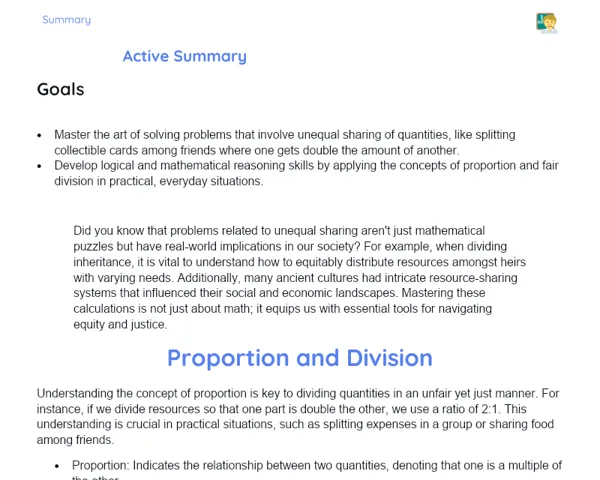Socioemotional Summary Conclusion
Goals
1. Grasp what injective and surjective functions mean.
2. Distinguish the differences between injective and surjective functions.
3. Apply the concepts of injective and surjective functions to real-life math problems.
4. Identify and express emotions when tackling challenging mathematical concepts.
5. Develop strategies to manage emotions during both setbacks and successes.
Contextualization
Did you know that injective and surjective functions aren't just abstract ideas but have practical uses too? For instance, they play a key role in database management and social network algorithms. By understanding these ideas, not only can we simplify complex mathematical problems, but we can also relate them to how we value unique relationships and manage our interactions. Ready to explore what more these functions can show us? Let’s dive in together!
Exercising Your Knowledge
Definition and Characteristics of Injective Functions
Consider a function f: A → B. It is deemed injective when every distinct element in A is paired with a distinct element in B. In simple words, no two different inputs share the same output. This uniqueness mirrors how we appreciate each individual’s distinctiveness in our everyday lives.
-
Distinct Elements: For any two elements, say x1 and x2 in A, if x1 ≠ x2 then it must be that f(x1) ≠ f(x2); ensuring every input gets its own unique output.
-
Uniqueness: The way injective functions highlight unique mappings is akin to recognising the individuality of each person—each one is special in their own right.
-
Practical Example: Take the function f(x) = 2x. Here, every value of x has its own corresponding double, proving the function is injective.
Definition and Characteristics of Surjective Functions
A function f: A → B is called surjective if every element in B is hit by at least one element in A. This means the codomain is completely covered by the outputs of the function. Think of it like ensuring every voice in a community is heard, much like our inclusive classroom discussions.
-
Complete Coverage: For every element b in B, there exists at least one element a in A such that f(a) = b; making sure nothing in B is left out.
-
Inclusivity: Much like a community meeting where every opinion matters, a surjective function ensures that all elements of the codomain are represented.
-
Practical Example: Consider the function f(x) = x². Over the real numbers, it is not surjective because it doesn't cover negative values. However, if we restrict the codomain to non-negative real numbers, then it becomes surjective.
Comparison between Injective and Surjective Functions
By comparing injective and surjective functions, we can appreciate each one’s special properties. While an injective function focuses on the uniqueness of each mapping, a surjective function guarantees that no element in the codomain is left out. This contrast reminds us of the balance between valuing individuality and ensuring inclusiveness in our interactions.
-
Uniqueness vs. Inclusivity: Injective functions ensure each input is mapped uniquely, whereas surjective functions strive to cover every element in the codomain.
-
Different Applications: Use injective functions in scenarios requiring unique identification, and surjective functions where complete coverage is vital.
-
Socio-Emotional Perspectives: Reflecting on these differences can help us appreciate both the uniqueness of each individual and the importance of making sure everyone feels included.
Key Terms
-
Injective Function: A function that ensures every element of the domain is matched with a unique element in the codomain.
-
Surjective Function: A function that makes sure every element in the codomain is the image of at least one element from the domain.
-
Domain: The complete set of input values for the function.
-
Codomain: The set that includes all potential outputs of the function.
-
Image: The set of actual outputs obtained after applying the function to every element in the domain.
For Reflection
-
How can understanding injective functions help you appreciate the uniqueness of individuals around you?
-
In what ways can the inclusive nature of surjective functions be used to ensure every voice is heard in a group?
-
What techniques for managing emotions do you find helpful when facing challenging topics like injective and surjective functions?
Important Conclusions
-
We have learned what injective and surjective functions are and how they differ.
-
We examined practical examples of these functions, helping us see how they apply to both math problems and everyday situations.
-
We recognized the value of expressing and managing our emotions during the learning process, especially when faced with challenging topics.
-
We discovered the importance of balancing uniqueness with inclusivity, and how these ideas resonate in our personal and social lives.
Impacts on Society
Injective and surjective functions play a significant role in various aspects of our daily lives – from the way our devices manage data to how social networks operate. By understanding these principles, we can better appreciate the logic behind algorithms that organise our digital world, making our online experiences smoother and more personalised.
Moreover, these functions remind us of the importance of both individual uniqueness and collective inclusiveness. Just as an injective function values each unique element, we learn to cherish the individuality of those around us. Conversely, surjective functions highlight the need to ensure that everyone has a chance to be heard, fostering a more inclusive community.
Dealing with Emotions
To manage your emotions effectively while studying injective and surjective functions, I suggest adopting the RULER method. Start by recognizing the emotions you feel when a tough problem slows you down—be it frustration, anxiety or even excitement. Next, try to understand the reason behind these feelings by identifying what triggered them. Name your emotions clearly and, if needed, share them with a friend or jot them down in your journal. Finally, use simple techniques like deep breathing or short breaks to regulate your emotions. This practice will not only enhance your understanding of mathematical concepts but also equip you to handle stress better in everyday situations.
Study Tips
-
Go over the examples discussed in class; linking these concepts to real-life applications is very helpful!
-
Make flashcards with the definitions and characteristics of injective and surjective functions to reinforce your memory.
-
Practice mindfulness and breathing exercises while studying to maintain a calm and productive mindset.



